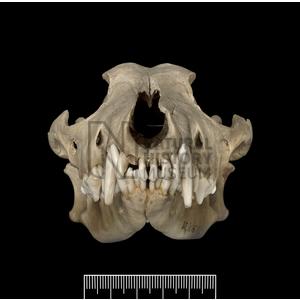Since then, biologists have also puzzled over the Falklands wolf's ancestry, with suggestions that they were related to domestic dogs, North American coyotes, or South American foxes. The wolves were the size of a coyote, but much stockier, with fur the color of a red fox. They had short muzzles, just like gray wolves, and thick, wooly fur.
Researchers reporting in Current Biology have compared DNA from four of the world's known Falklands wolf museum specimens to that of living canids and say they have new insight into the evolutionary ancestry of these enigmatic carnivores.

Possible explanations for the wolves' presence on the islands, which have never been connected to the South American mainland, range from dispersal by ice or logs to domestication and subsequent transport by Native Americans. Ultimately, the Falklands wolf died out because it was perceived as a threat to settlers and their sheep, although fur traders took out a lot of the population as well.
"One of the big draws for an evolutionary biologist is that this species had a big influence on Darwin's ideas about how species evolve," said Graham Slater of the University of California, Los Angeles, noting that Darwin recognized differences between the East Falkland and West Falkland wolves as evidence that species are not fixed entities. But the wolves' circumstances were also just downright puzzling.
"It's really strange that the only native mammal on an island would be a large canid," Slater explained. "There are no other native terrestrial mammals—not even a mouse. It's even stranger when you consider that the Falklands are some 480 kilometers from the South American mainland. The question is, how did they get there?"

Slater's team now reports that the Falklands wolf's closest living relative is actually the maned wolf—an unusually long-legged, fox-like South American canid. The researchers also found that the four Falklands wolf samples that they examined shared a common ancestor at least 70,000 years ago, which suggests that they arrived on the islands before the end of the last ice age and before humans ever made it into the New World. That rules out the prevailing theory that Native Americans had anything to do with their presence on the islands.
"The biggest surprise was that the divergence of the Falklands wolf from its closest living relative, the maned wolf, occurred over 6 million years ago," Slater said. "Canids don't show up in the South American fossil record until 2.5 million years ago, which means these lineages must have evolved in North America. The problem is that there are no good fossils that can be assigned to the Falklands wolf lineage in North America."
Given that maned and Falklands wolves split so long ago, there should be fossils of their close relatives in South America, Slater said. And in fact, the researchers may have a candidate: a species from Patagonia called Dusicyon avus, which went extinct 6,000 to 8,000 years ago. Slater says that's a possibility that study coauthor Alan Cooper at the University of Adelaide in Australia is further investigating now.




Comments